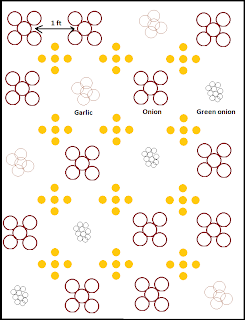 |
| Click to embiggen |
This is what I based the majority of my companioning on. The plant guide is extensive and has some helpful hints for deterring pests. I wasn't planning on planting potatoes this year because my youth is full of memories of handpicking disgusting potato bugs. However, after reading this, there are a number of plants that can help with that problem. So now I plan on throwing some cilantro (coriander) and marigolds around amidst the potatoes and we'll see how much of a problem I actually have!
One thing you might have noticed is that the layout is not the traditional row-of-plants, walking-row sequence. I don't know why, but I had to actually be told that so many walking rows are unnecessary. To utilize the space more effectively, it makes much more sense to plants things in large blocks of garden bed. This is my MSPaint rendition of John Jeavons chart showing the ridiculous difference between rows and blocks.
 |
| Count 'em up, people. 21 plants in the block bed, 15 plants in rows. |
Another argument for block beds is weeds - if your veggies are thick enough, they'll choke out the weeds.
You also might have noticed that I put my squash and cucumbers right next to each other. There is a myth out there that says them must be far apart to prevent cross-pollination. I have read several sites that say this is a myth. But even if you still adhere to this myth, it's important to note that if cross-pollination occurs, it won't affect this season's harvest. If you save the seeds, it's possible that you might grow something weird (but this is only going to happen if have maybe two squashes the cross-pollinate).
Another thing you might have noticed is that I have a couple areas where I have interspersed blocks of different veggies.
Here's what's going on. Let's say I just planted broccoli there. Broccoli takes a while to reach full size, which means early in the season, there are empty spaces between plants. Empty spaces in the garden are where weeds grow. Alternatively, I can plant a fast-maturing plant there and harvest it before the broccoli get big enough to choke everything out. Double harvest in a single space! Talk about utilizing your space effectively.
Things get a little crazier when we get over to the onion/carrot/garlic area. Not only are all of those plants companions, but garlic also chases away many pests. I'm also going to employ another new technique in this section called multi-planting. From Jeavon's book, "The concept of the multiplant block is based on spatial rather than linear plant distance in the field. For example, say the average ideal in onion spacing is one plant every 3 inches in rows spaced 12 inches apart. Mutiplants aim at an equivalent spacing of four or five onions per square foot. The difference is that all four onions are started together in one block and grow together until harvest....The onions grow normally in the clump, gently pushing each other aside, attaining a nice round bulb shape and good size." Benefits: more onions per square foot. Only I'm going to intersperse the onions with garlic and green onions too.
Okay, so there's some info on companion planting as well as a few other planting techniques. I didn't get too in-depth on this one, so by all means, leave any questions in the comments!



No comments:
Post a Comment